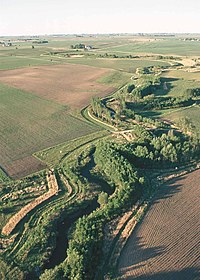
Photo from wikipedia
Many rivers in Central Europe are heavily affected by increased sedimentation due to erosion from agricultural land. High fine sediment loads can clog the interstitial system, increase turbidity, limit light… Click to show full abstract
Many rivers in Central Europe are heavily affected by increased sedimentation due to erosion from agricultural land. High fine sediment loads can clog the interstitial system, increase turbidity, limit light penetration and potentially reduce primary productivity with negative impacts on stream biota such as reduced abundance and diversity. In this study, the effects of different erosion protection measures on instream sedimentation and the communities of fishes, macroinvertebrates and periphyton were evaluated. The erosion protection measures in the catchment successfully reduced the fine-sediment and nutrient input into the river system resulting in positive effects on interstitial habitat quality and the species assemblage of the assessed biota. The single taxonomic groups differed in their response both to catchment-related and instream-related variables. Fish community composition was best explained by catchment-scale variables, while periphyton and macroinvertebrate assemblage structure was significantly governed by instream-scale variables. For increasing restoration success, a combination of measures in the catchment area with structure-enhancing measures within the stream is necessary. The results also suggest that an integrative assessment of abiotic and biotic variables in monitoring increases the detectability of effects on the instream scale.
Journal Title: Hydrobiologia
Year Published: 2018
Link to full text (if available)
Share on Social Media: Sign Up to like & get
recommendations!